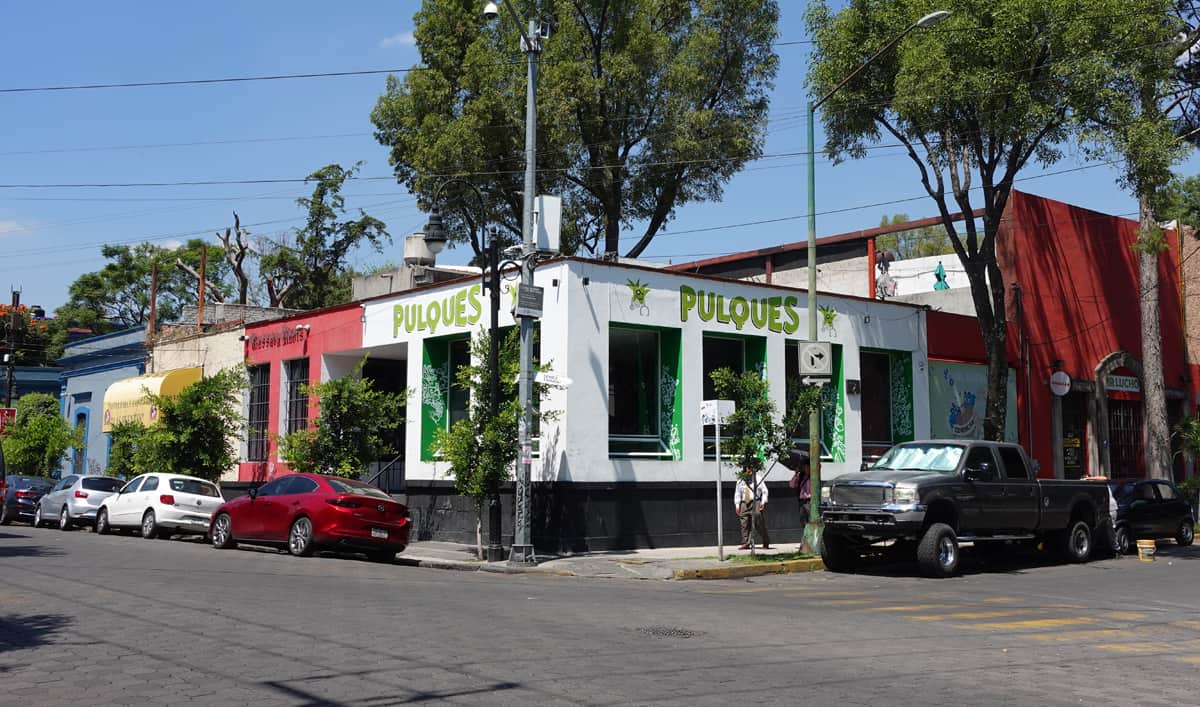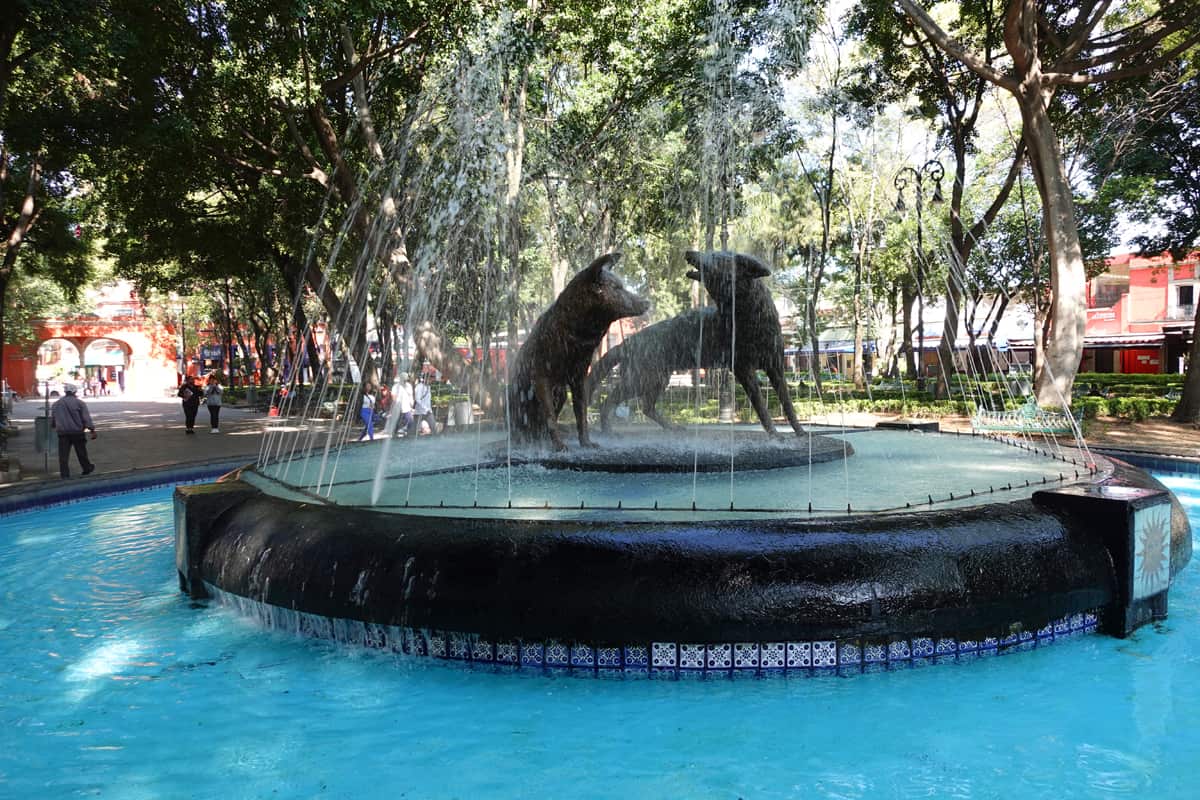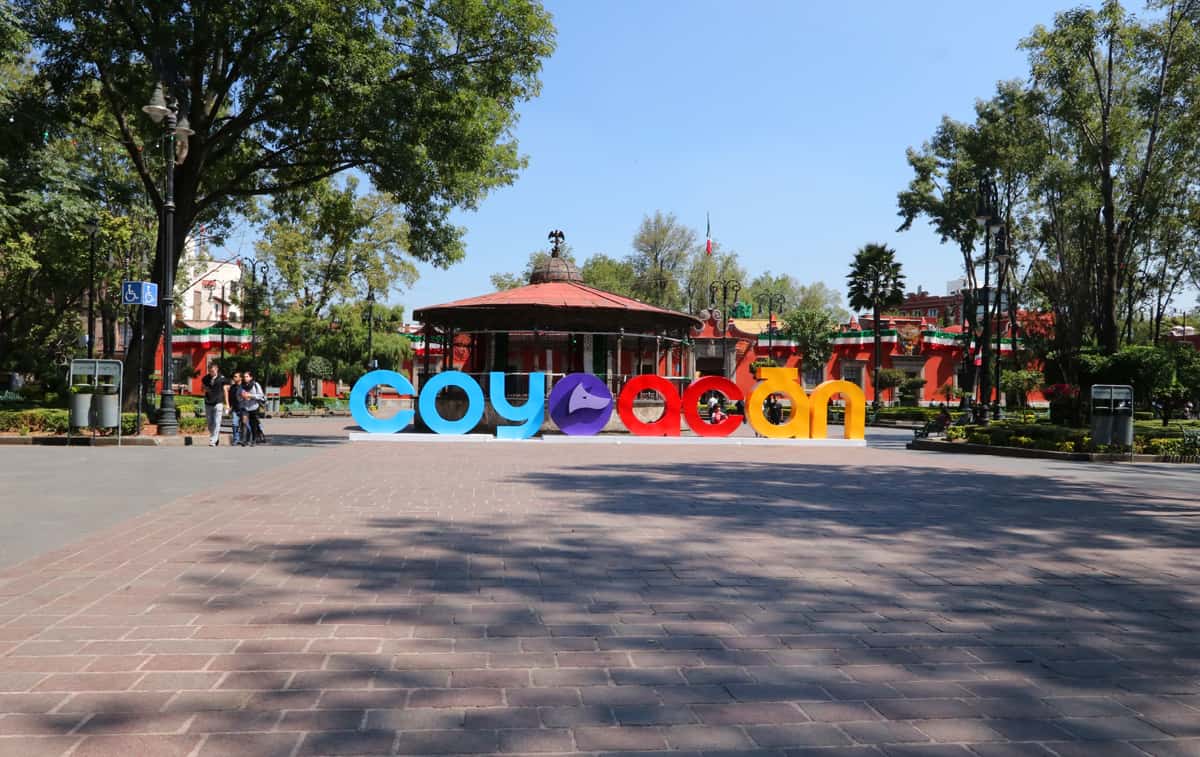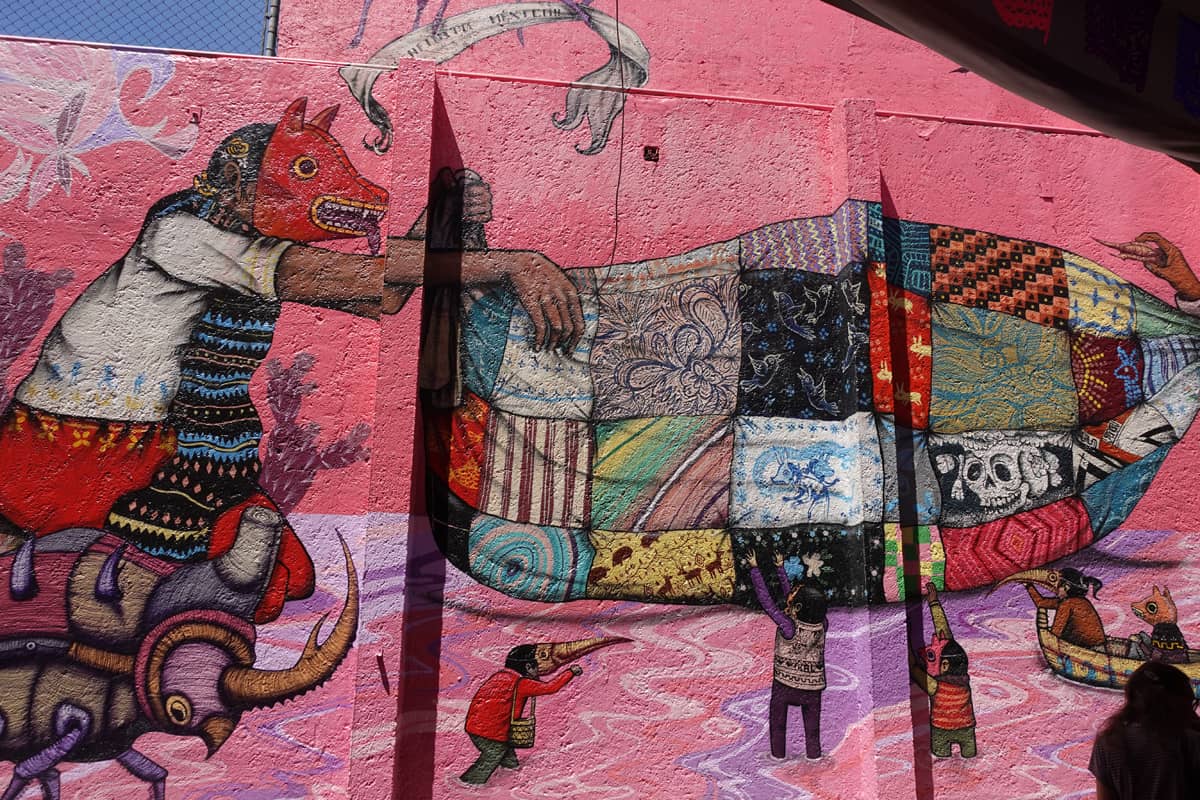
The highlights of Coyoacán
Most visitors coming to Mexico City visit Coyoacán with the sole purpose of seeing the Frida Kahlo Museum. While Frida fans should visit the museum, there are highlights in Coyoacán that are (in my opinion) more worthwhile. I’ll get into that more later.
This post covers the Frida Kahlo museum, lists Coyoacán’s other highlights, and gives you an idea what you can expect visiting the neighbourhood.
Note: we visited Coyoacán on a private tour with Vibe Adventures. It was a great way to get an in-depth appreciate of the neighbourhood.
What makes Coyoacán special
Coyoacán is Mexico City’s oldest neighbourhood in the period since colonial rule. When Hernán Cortés came here in 1519 to take Tenochtitlan (present day Mexico City and at the time the capital of the Aztec Empire) he made Coyoacán the capital of New Spain.
By 1521 the Spanish had wiped out Tenochtitlan. They then set about reconstructing it, building a colonial city in its place. Only when this was done was the capital shifted from Coyoacán to Mexico City.
After the move, Coyoacán remained an independent village separate from Mexico City. It was only in 1857 that it was incorporated into the Federal District of Mexico City.
Today Coyoacán still feels a world away from Mexico City. It is a green, leafy neighbourhood that’s spread out. You’ll find lots of colonial buildings, parks, and monuments along the way. We visited during the week and it was very quiet. Weekends are a whole other matter however; the neighbourhood gets flooded with visitors.
Getting there
It is not the most accessible neighbourhood. You can take an Uber. But considering Mexico City’s traffic, the best and cheapest way is by public transport.
I’ll tell you how we got there: Take Metro Station line 2 (blue) from the centro Historico. You can take it at Bellas Artes or at Pino Suárez as we did. Go in the direction of Tasqueña. Get out at General Anaya metro station (that should take you about 20 minutes). When you get out of the station, look to the left of the station on the side road. There are bus stops there. Bus 34 costs 6 pesos and takes you straight to Plaza Hidalgo (Coyoacán’s main square) in about 15 minutes. Total time about 35 minutes, cost 12 pesos/person. This post covers different ways of getting to the center of Coyoacán from different parts of the city.
The Highlights of Coyoacán
At the center of Coyoacán is Plaza Hidalgo. It’s where we got off the little bus that took us from the General Anaya metro station. It’s a large, beautiful square and you’ll notice the back of a huge church. I’ll get to that in a second. We had a bit of time before meeting our guide Avi so we got ourselves a coffee and a croissant (there’s a large Starbucks on the square) and sat in the square.
Parroquia San Juan Bautista (also known as la Iglesia de Coyoacán)
It is an extraordinary church (and convent) and one of the oldest in Mexico. Hernán Cortés granted the land to the Franciscans and soon after (in 1522) construction started. The cross in front is said to be from the time of the founding of Coyoacán. It took 30 years to build the church and the convent.
The church has been remodelled with time and most of what you see today dates back to 1804. Full of baroque mouldings and glittering with gold, the highlight for me was the wide ceiling (which seemed unlike any other church I’ve seen in Mexico) and the incredible ceiling frescos (scenes from the life of Christ).
You can wander through the convent and appreciate the beautiful cloister.
Fuente de los Coyotes (Coyotes fountain)
In Parque Centenario, right next to Plaza Hidalgo, is this fountain. “Coyoacán” is a Aztec word meaning ‘place of the coyotes’ and you’ll see statues and sculptures of coyotes throughout Coyoacán. In Aztec times, this area was forest and there would have been a lot of coyotes here, hence the name.
Note: One of the most ancient Aztec deities is Huehuecoyotl, which translates as “Old Coyote.” He was seen as a wise yet hedonistic and mischevious trickster god with dualistic qualities. The coyote god was often associated with indulgent behavior, partying, storytelling, and male sexual prowess, and Aztec mythology had many folktales regarding the many beautiful goddesses he seduced. Such stories invariably feature Huehuecoyotl as a comical figure who either outwits through his cunning the angry gods that he has cuckolded or else is viciously punished by them for his mischief. Source.
Plaza Hidalgo
Walking back a few steps to Plaza Hidalgo, you’ll see a few noteworthy sights: a large Coyoacán sign (the Mexicans love to adorn their towns and cities with them), a kiosk (gazebo) which is something else you’ll always see in Mexican squares (its origins are Turkish but Europeans embraced them in the 17th and 18th centuries), and the Coyoacán Municipal building.

Iglesia de la Inmaculada Concepción
Built starting in 1525, it’s the oldest church in Mexico (it’s in fact supposed to be the oldest Christian building in New Spain). It was built over a Toltec monument by the Spanish. Despite looking a bit worn, it is an active church and Ari told us that you can attend mass here on Sundays. It’s nicknamed “La Conchita” and is located in “Plaza de la Conchita” across the street from Parque Frida Kahlo.
Parque Frida Kahlo
Frida Kahlo Park was inaugurated in 1984 as a tribute to Frida (who died in 1954). If you’re a Frida fan you’ll want to visit and enjoy the statues of both Frida Kahlo and her husband Diego Rivera.
Hacienda de Cortés
The Hacienda de Cortés was one of our biggest surprises in Coyoacán. This large property has a big mansion surrounded by gardens and beautiful architecture. The property used to house the stables of Hernán Cortés and has been the home of many famous Mexican artists.
Today it has a large restaurant, bar, and has conference and banquet facilities. As I say, it is a beautiful property and makes for a great stop while walking around Coyoacán (although reviews suggest that the service in the restaurant is terrible).
Museo Nacional de las Culturas Populares
The museum of Popular Cultures (Museo Nacional de las Culturas Populares) has exhibits containing indigenous art. It gets very good reviews on the internet and if you have time it’s worth the visit. But we were just passing through – they had some kind of conference with various exhibits, vendors and people handing out free drinks.
The Frida Kahlo Museum
The Frida Kahlo Museum is the reason most people come to Coyoacán.
This museum, the house where she was born and spent much of her life, is one of Mexico City’s most popular museums and it is dedicated to her life and work.
Frida had a painful life: at 6 years old she contracted polio which made one leg shorter and skinnier than the other. At 18 she was in a bus which had an accident with a trolley. She had serious injuries including a broken spinal column, a broken collarbone, broken ribs, 11 fractures to her right leg and a crushed and dislocated right foot. A handrail also pierced her abdomen, rendering her incapable of ever having children. She was in constant pain in her life (she had 35 surgeries, mainly on her back) and it is reflected in her work. A few days before dying in 1954 (at the age of 47) she wrote in her diary “I hope the exit is joyful – and I hope to never return”.



I first visited the Frida Kahlo museum in 2016. It was already popular then. These days there’s always a long line outside. Best to buy your tickets in advance on the official website.
Honest thoughts on the Frida Kahlo museum? I think it’s become a tourist trap…one of those places where young people visit to take selfies. It’s no wonder they can afford to charge 250 pesos/person.
Having been here in 2016 and coming back this time around (we came back for Lissette who’s never visited), I didn’t enjoy being herded, along with a hundred other people, through the narrow confines of the museum.
Verdict? If you’re a real Frida fan then come here. It’s where she grew up and died, so you get to walk in her footsteps. But if you’re not a huge fan then I suggest you skip the museum. We enjoyed the tour – Coyoacán has lots to see – but the Frida Kahlo museum was just too popular for our liking.
Leon Trotsky’s House Museum
Not far from the Frida Kahlo Museum is the Leon Trotsky’s House Museum. Leon Trotsky was a guest and friend of Frida Kahlo and Diego Rivera until he and Frida had an affair…upon which he was asked to move by Diego Rivera. It was in this house that Trotsky was assassinated.
For those unfamiliar with Leon Trotsky: He, along with Vladimir Lenin, were the architects of the 1917 Bolshevik revolution in Russia. He was a devout Marxist, served as Commissioner of Foreign Affairs and founded the Soviet Union’s Red Army. After Lenin died in 1924, his arch-rival Joseph Stalin came into power. Trotsky went into exile, living in Turkey, France and Norway before making his way to Mexico in 1937. In 1940 he was assassinated in his home by an agent of the Soviet Union.
It’s definitely worth a visit if you’re a fan of history.
There are other things to see in Coyoacán if you have more time: you can visit the Mercado de Coyoacán, shop for souvenirs at the Mercado Artesanal Mexicana, see the Anahuacalli Museum (a museum with Diego Rivera murals…but’s it’s about 15 minutes from Coyoacán).
Accommodation: Coyoacán is increasingly a place where tourists and expats stay – one expat mentioned to us that he chose Coyoacán because it is less susceptible to earthquakes (unlike other neighbourhoods such as Roma Norte, it is not built on landfill). A few recommended places: Casa Molcajete is well located, well priced and fully equipped. Great for a longer stay. For a shorter, more luxurious stay, Casa Jacinta Guest House is a highly recommended bed and breakfast.
Tour: As mentioned at the top, on this visit we took this private tour with Vibe Adventures.





























Great article, thank you!